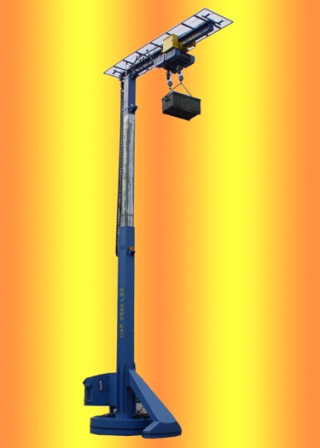
Air Technical Industries has developed and built a very unique and versatile mobile Telescopic Mast Jib Crane with OMNI-DIRECTIONAL mobility for handling various components that need to be lifted during the aircraft manufacturing process.
The large prefabricated components weighing up to 3,500 pounds need to be lifted up to 36' high, transported into position, and articulated into the precise orientation for assembly. ATI's stationary Telescopic Mast Jib Cranes have been used in other similar operations. The new concept of modular design requires much more flexibility and
OMNI-DIRECTIONAL mobility.
ATI developed a new design of Telescopic Mast Jib Crane with
Omni-directional mobility that enables the production crew to reach
over, under and if necessary, into the airplane to position components
during the assembly process.
The new crane model with unique Omni-directional mobility allows the
crane to travel in any direction 360° and it can turn within its own
measurements (similar to the way a military tank turns). The crane's
mast, a rotating turret, is capable of swinging left and right fully
loaded. The telescopic section of the mast is chrome plated for smooth
travel and to prevent corrosion. It telescopes up to 36' under-hook
height. The beam of the crane has 13.5' of reach and is equipped with
dual hoists, one with a motorized trolley and the other a push/pull
trolley to "float", accommodating movement and articulation of the load.
The two hoists are used to rotate components, such as the horizontal
stabilizer, from vertical to horizontal position.
The mast rotation helps in placing the component precisely to the
fuselage for fastening. The hoist lifting speed is variable up to 32'
per minute and the hoists operate independently. The beam of the crane
is equipped with emergency stop bars to automatically stop operation in
case it touches a stationary object to prevent any damage.
The mobile base has a round design since it travels in any direction.
That makes it easy to go around corners and crowded areas. The base is
built of heavy steel construction with built-in drive system. The power
pack with counterweights, battery, controls, valves, battery charger,
pump, and motor are all enclosed and protected while serving as
counterweight. Opposite the power pack is a single mobile outrigger that
rotates and travels with the mast. This system makes the unit a unique,
compact, innovative, and functional design.
Propulsion is driven by two heavy-duty 24 volt DC gear motor driven
polyurethane wheels controlled separately via joysticks for directional
control and smooth acceleration and deceleration. It has infinitely
variable speed from 0 to 3 MPH. The wheels have built-in automatic
braking. The traction wheels can be retracted from the floor if towing
should ever be required. The power pack consists of dual power systems.
24 volt DC (48V available) is used for propulsion, steering, turret
rotation and telescopic mast action. The wire rope hoists, motorized
trolley, and built-in battery charger are powered by 240/480 volts/AC/3
Phase.
In case of power failure, systems are all designed to hold the load
securely and all functions stop and lock in its present position. Other
safety features include: on-board fire extinguisher, battery monitoring
gauge, audible alarm system, traveling amber warning light, emergency
stop, and overload protection. Hydraulic system is equipped with a
safety pressure relief valve and the telescopic cylinder has an
over-center holding valve to prevent mast from lowering inadvertently in
the event of a hydraulic system failure.
Various components need to be lifted and precisely positioned during the
airplane building process:
Lifting the horizontal stabilizer from the shipping container,
transporting it in a vertical position, then positioning it with the
secondary hoist with the leading edge forward 90° to a horizontal
position, and positioning it laterally with turret rotation for precise
installation. Afterward, it is used for removal of the lifting fixture
for storage and next use.
Lifting and positioning engine pylons and installing onto the wings to
be fastened.
Handling and installing engine cowlings.
Lifting and positioning thrust reversers for installation.
Lifting, transporting, and positioning inboard & outboard flaps for
installation.
Miscellaneous handling of tooling, jigs, or fixtures, with the ability
to articulate into the proper orientation.
The Omni Directional Telescopic Mast Jib Crane is really a dream come
true in helping to build planes of the future or for that matter
handling, transporting, and positioning of large components in any
operation precisely, safely and ergonomically.